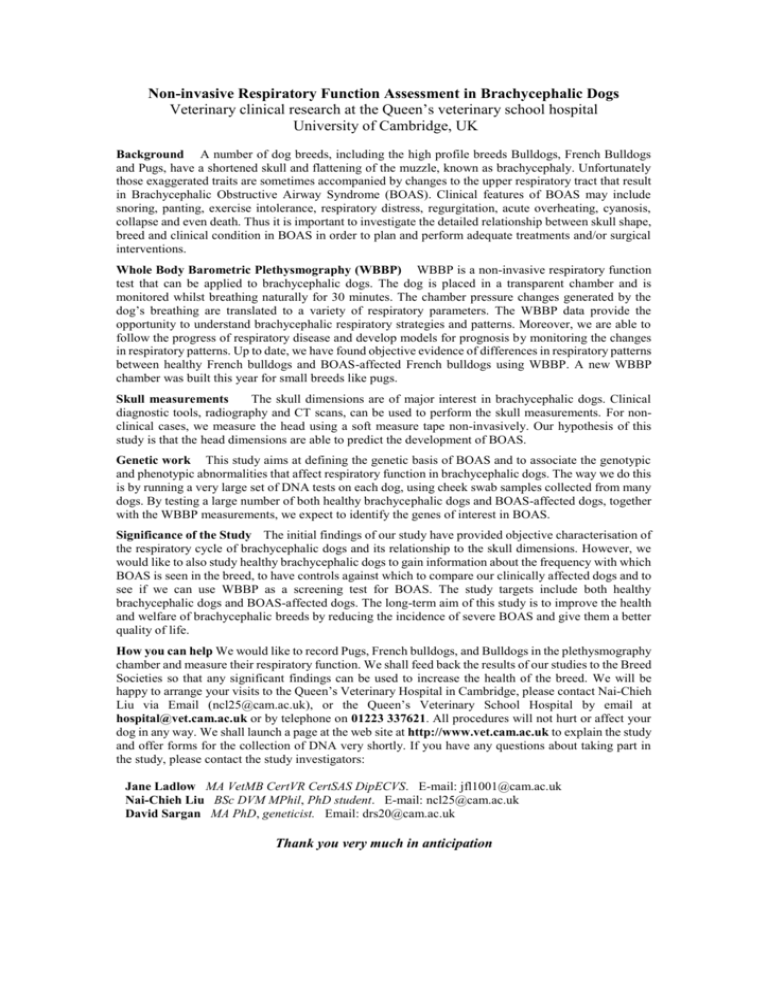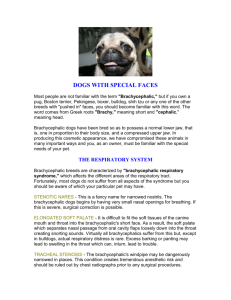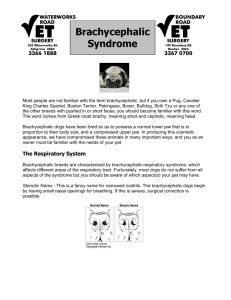Non-invasive Respiratory Function Assessment in
advertisement

Non-invasive Respiratory Function Assessment in Brachycephalic Dogs Veterinary clinical research at the Queen’s veterinary school hospital University of Cambridge, UK Background A number of dog breeds, including the high profile breeds Bulldogs, French Bulldogs and Pugs, have a shortened skull and flattening of the muzzle, known as brachycephaly. Unfortunately those exaggerated traits are sometimes accompanied by changes to the upper respiratory tract that result in Brachycephalic Obstructive Airway Syndrome (BOAS). Clinical features of BOAS may include snoring, panting, exercise intolerance, respiratory distress, regurgitation, acute overheating, cyanosis, collapse and even death. Thus it is important to investigate the detailed relationship between skull shape, breed and clinical condition in BOAS in order to plan and perform adequate treatments and/or surgical interventions. Whole Body Barometric Plethysmography (WBBP) WBBP is a non-invasive respiratory function test that can be applied to brachycephalic dogs. The dog is placed in a transparent chamber and is monitored whilst breathing naturally for 30 minutes. The chamber pressure changes generated by the dog’s breathing are translated to a variety of respiratory parameters. The WBBP data provide the opportunity to understand brachycephalic respiratory strategies and patterns. Moreover, we are able to follow the progress of respiratory disease and develop models for prognosis by monitoring the changes in respiratory patterns. Up to date, we have found objective evidence of differences in respiratory patterns between healthy French bulldogs and BOAS-affected French bulldogs using WBBP. A new WBBP chamber was built this year for small breeds like pugs. Skull measurements The skull dimensions are of major interest in brachycephalic dogs. Clinical diagnostic tools, radiography and CT scans, can be used to perform the skull measurements. For nonclinical cases, we measure the head using a soft measure tape non-invasively. Our hypothesis of this study is that the head dimensions are able to predict the development of BOAS. Genetic work This study aims at defining the genetic basis of BOAS and to associate the genotypic and phenotypic abnormalities that affect respiratory function in brachycephalic dogs. The way we do this is by running a very large set of DNA tests on each dog, using cheek swab samples collected from many dogs. By testing a large number of both healthy brachycephalic dogs and BOAS-affected dogs, together with the WBBP measurements, we expect to identify the genes of interest in BOAS. Significance of the Study The initial findings of our study have provided objective characterisation of the respiratory cycle of brachycephalic dogs and its relationship to the skull dimensions. However, we would like to also study healthy brachycephalic dogs to gain information about the frequency with which BOAS is seen in the breed, to have controls against which to compare our clinically affected dogs and to see if we can use WBBP as a screening test for BOAS. The study targets include both healthy brachycephalic dogs and BOAS-affected dogs. The long-term aim of this study is to improve the health and welfare of brachycephalic breeds by reducing the incidence of severe BOAS and give them a better quality of life. How you can help We would like to record Pugs, French bulldogs, and Bulldogs in the plethysmography chamber and measure their respiratory function. We shall feed back the results of our studies to the Breed Societies so that any significant findings can be used to increase the health of the breed. We will be happy to arrange your visits to the Queen’s Veterinary Hospital in Cambridge, please contact Nai-Chieh Liu via Email (ncl25@cam.ac.uk), or the Queen’s Veterinary School Hospital by email at hospital@vet.cam.ac.uk or by telephone on 01223 337621. All procedures will not hurt or affect your dog in any way. We shall launch a page at the web site at http://www.vet.cam.ac.uk to explain the study and offer forms for the collection of DNA very shortly. If you have any questions about taking part in the study, please contact the study investigators: Jane Ladlow MA VetMB CertVR CertSAS DipECVS. E-mail: jfl1001@cam.ac.uk Nai-Chieh Liu BSc DVM MPhil, PhD student. E-mail: ncl25@cam.ac.uk David Sargan MA PhD, geneticist. Email: drs20@cam.ac.uk Thank you very much in anticipation (Figure 1) A French bulldog is undergoing a WBBP test (Figure 2) The waveforms from the WBBP (Figure 3) Radiographic skull measurements









